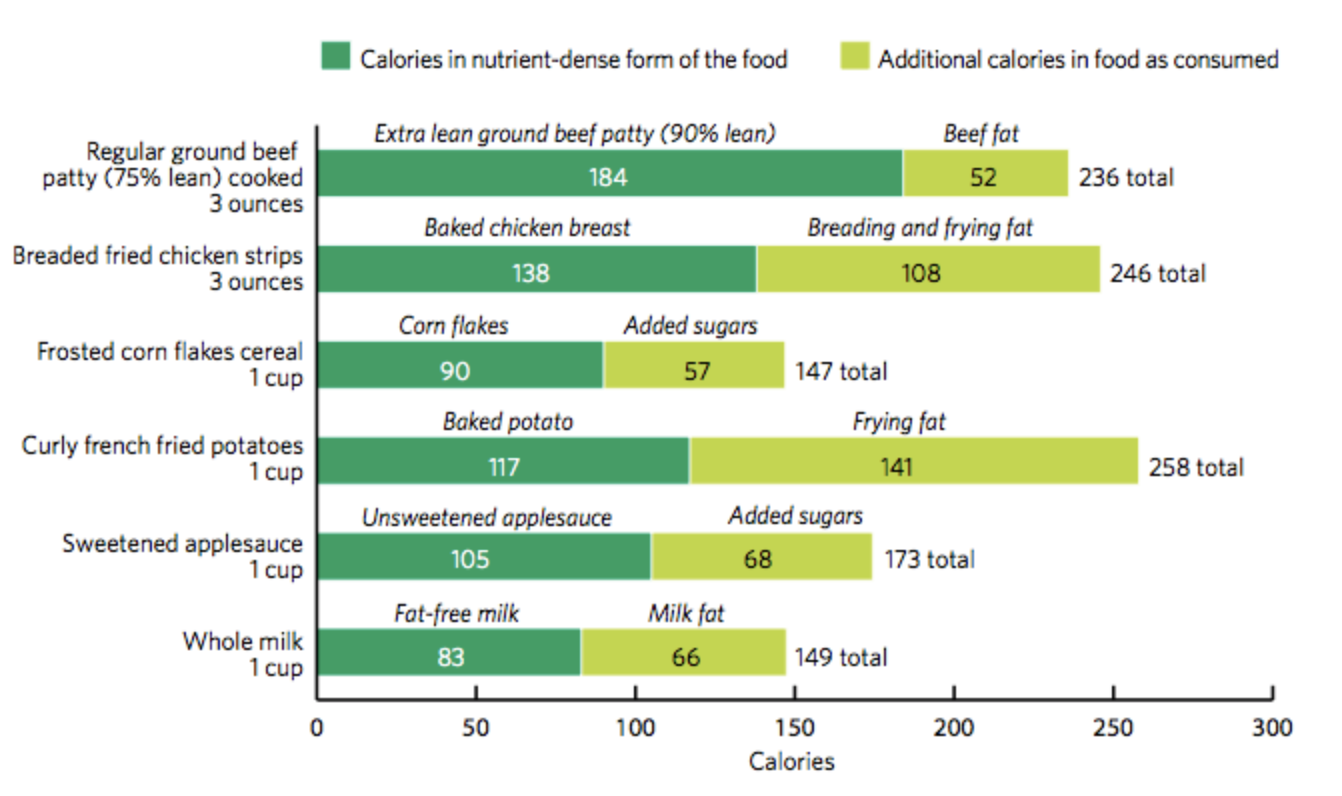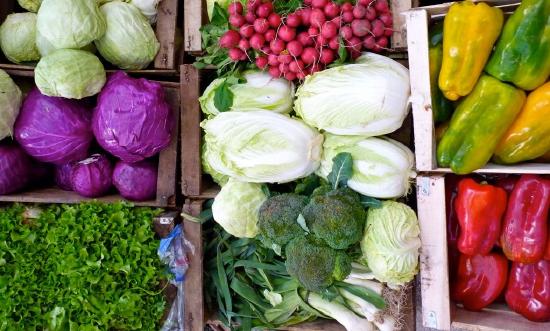4.1: What is a Healthy Diet?
- Page ID
- 39197
- Define the components of a healthful diet.
Good nutrition means eating the right foods, in the right amounts, to receive enough (but not too much) of the essential nutrients so that the body can remain free from disease, grow properly, work effectively, and feel its best. The phrase “you are what you eat” refers to the fact that the food you eat has cumulative effects on the body. And many of the nutrients obtained from food do become a part of us. For example, the protein and calcium found in milk can be used in the formation of bone. The foods we eat also impact how we feel—both today and in the future. Below we will discuss the key components of a healthy diet that will help prevent chronic disease (like heart disease and diabetes), maintain a healthy weight, and promote overall health.
ACHIEVING A HEALTHY DIET
Achieving a healthy diet is a matter of balancing the quality and quantity of food that you eat to provide an appropriate combination of energy and nutrients. There are five key characteristics that make up a healthful diet:
- Adequacy
- Balance
- Nutrient density
- Moderation
- Variety
Adequacy
A diet is adequate when it provides sufficient amounts of calories and each essential nutrient, as well as fiber. Most Americans report not getting enough fruit, vegetables, whole grains or dairy, which may mean falling short in the essential vitamins and minerals found in these food groups, like Vitamin C, potassium, and calcium, as well as fiber.1
Balance
A balanced diet means eating a combination of foods from the different food groups, and because these food groups provide different nutrients, a balanced diet is likely to be adequate in nutrients. For example, vegetables are an important source of potassium, dietary fiber, folate, vitamin A, and vitamin C, whereas grains provide B vitamins (thiamin, riboflavin, niacin, and folate) and minerals (iron, magnesium, and selenium). No one food is more important than the other. It is the combination of all the different food groups (fruit, vegetables, grains, dairy, protein and fats/oils) that will ensure an adequate diet.

Nutrient Density
Nutrient Density is a measure of the nutrients that we’re usually trying to consume more of—vitamins, minerals, fiber and protein—per calorie of food, coupled with little or no solid fats, added sugars, refined starches, and sodium. For example, in the screenshot below, a 90 percent lean 3-ounce ground beef patty is considered more nutrient-dense than a 75 percent lean patty. In the 90 percent lean patty, for 184 calories you get protein, iron, and other needed nutrients. On the other hand, the 75 percent lean patty has 236 calories, but the extra 52 calories add only solid fats and no other appreciable nutrients.

All vegetables, fruits, whole grains, seafood, eggs, beans and peas, unsalted nuts and seeds, fat-free and low-fat dairy products, and lean meats and poultry — when prepared with little or no added solid fats, and sugars — are nutrient-dense foods.
Foods become less nutrient dense when they contain empty calories — calories from solid fats and/or added sugars. Solid fats and added sugars add calories to a food but don’t provide other nutrients. Foods with empty calories have fewer nutrients per calorie; therefore, they are less nutrient dense.
Examples of foods HIGH in empty calories:
- doughnuts, cakes, cookies
- sweetened cereals and yogurt
- sweetened beverages
- high-fat meats
- fried foods
- alcohol
Examples of nutrient-dense foods:
- whole grains like brown rice, whole wheat bread and pasta, barley, and oatmeal
- plain, nonfat milk and yogurt
- beans, nuts, and seeds
- lean meats
- whole, fresh fruits and vegetables
You can choose more nutrient-dense foods by making small modifications to your current eating pattern. Examples include preparing foods with less fat by baking versus frying, purchasing items like cereals and fruits with less added sugar, and focusing on eating foods in their natural state versus adding a lot of extra fat, sugar and sodium.
Keep in mind that empty calories are not always a bad thing. In fact, empty calories can help promote eating more nutrient-dense foods. Adding a little fat and/or sugar to nutrient-dense foods can add flavor, making the food more enjoyable. A teaspoon of sugar in oatmeal, or a teaspoon of butter on steamed veggies is a great way to include empty calories. In these cases, the calories come packaged with other nutrients (since they are added to whole foods), whereas the empty calories in soda come with no other nutrients, only added sugar.
| Instead of… | Replace with… |
|---|---|
| Sweetened fruit yogurt | Plain fat-free yogurt with fresh fruit |
| Cheese | Low-fat or reduced-fat cheese |
| Bacon or sausage | Canadian bacon or lean ham |
| Fried chicken | Baked chicken with herbs |
| White bread, white rice | Whole-grain bread, brown rice |
| Sweetened cereals | Minimally sweetened cereals with fresh fruit |
| Apple or berry pie | Fresh apple or berries |
| Deep-fried French fries | Oven-baked French fries or sweet potato baked fries |
| Fried vegetables | Steamed or roasted vegetables |
| Sugary sweetened soft drinks |
Water, or seltzer mixed with 100 percent fruit juice |
| High-sodium canned beans | Low-sodium canned beans or home-cooked dried beans |
| Canned fruit in syrup | Fresh or frozen fruit without added sugars |
Moderation
Moderation means not eating to the extremes, neither too much nor too little of any one food or nutrient. Moderation means that small portions of higher-calorie, lower-nutrient foods like chips and candy can fit within a healthy diet. Including these types of foods can make healthy eating more enjoyable and also more sustainable. When eating becomes too extreme—where many foods are forbidden—this eating pattern is often short-lived until forbidden foods are overeaten. Too many food rules can lead to a cycle of restriction-deprivation-overeating-guilt.2 For sustainable, long-term health benefits, it is important to give yourself permission to eat all foods.

Variety
Variety refers to consuming different foods within each of the food groups on a regular basis. Eating a varied diet helps to ensure that you consume adequate amounts of all essential nutrients required for health. One of the major drawbacks of a monotonous diet is the risk of consuming too much of some nutrients and not enough of others. Trying new foods can also be a source of pleasure—you never know what foods you might like until you try them.
References
- U.S. Department of Agriculture and U.S. Department of Health and Human Services. (2020). Dietary Guidelines for Americans, 2020-2025, 9th Edition. Retrieved from https://www.dietaryguidelines.gov/
- Rumsey, A. (2018, Janurary 8) Why Eating Fewer Calories Won’t Help You Lose Weight. U.S. News. Retrieved from https://health.usnews.com/health-news/blogs/eat-run/articles/2018-01-08/why-eating-fewer-calories-wont-help-you-lose-weight
Attributions
Nutrition: Science and Everyday Application by Alice Callahan, PhD, Heather Leonard, MEd, RDN, and Tamberly Powell, MS, RDN is licensed under a Creative Commons Attribution-NonCommercial 4.0 International License, except where otherwise noted. Available at: https://openoregon.pressbooks.pub/nutritionscience/
Content on this page is adapted from the following sources under an open-licensing agreement:
- Zimmerman M. 1.4: The Broad Role of Nutritional Science. Introduction to Nutrition (Zimmerman). Accessed 12/13/2020 at Content Reuse Link: Bookshelves/Nutrition/Book%3A_An_Introduction_to_Nutrition_(Zimmerman)/02%3A_Achieving_a_Healthy_Diet/2.03%3A_What_Is_Nutritional_Balance_and_Moderation%3F

